After a short overnight cruise from Komodo Island, we arrived at the Island of Bali. We were welcomed at the port by traditional Balinese dancers and musicians.

Bali is a Hindu nation and most of the architecture and lifestyle are based on these precepts. The Balinese celebrate the international New Year but also celebrate the Balinese New Year on March 7th which is called “Nyepi”, “Day of Silence”. On this day, no one can work, no travel is allowed (the airport is closed for 24 hours), no fires can be lit thus no cooking, no entertainment or pleasure (no radio, TV, internet). It is a day of silence, fasting, and meditation.
Our tour today was “East Bali Heritage” where we visited three significant historical locations in Balinese history: Klungkung Palace, Pura Kehen Temple, and the royal palace in Blahbatuh.
As we drove through the streets on our way to our first stop, we noticed a lot of these bamboo decorations hanging everywhere. These are called “Penjor”.
Penjor are tall tapered decorated poles hung in front of Balinese Hindu homes or businesses and made from bamboo. They are erected to symbolize the dominance of good (dharma) over evil (adharma) as well as to offer thanks to the gods. The curved part of the penjor thus symbolizes Mount Agung, the highest mountain in Bali that is considered the home of the gods. Roughly halfway down the pole is a structure called sanggah cucuk. This may be triangular in shape or it may be a simple “cage” and is used to place offerings for the gods when they come down to Earth for the religious celebration of Galungan.
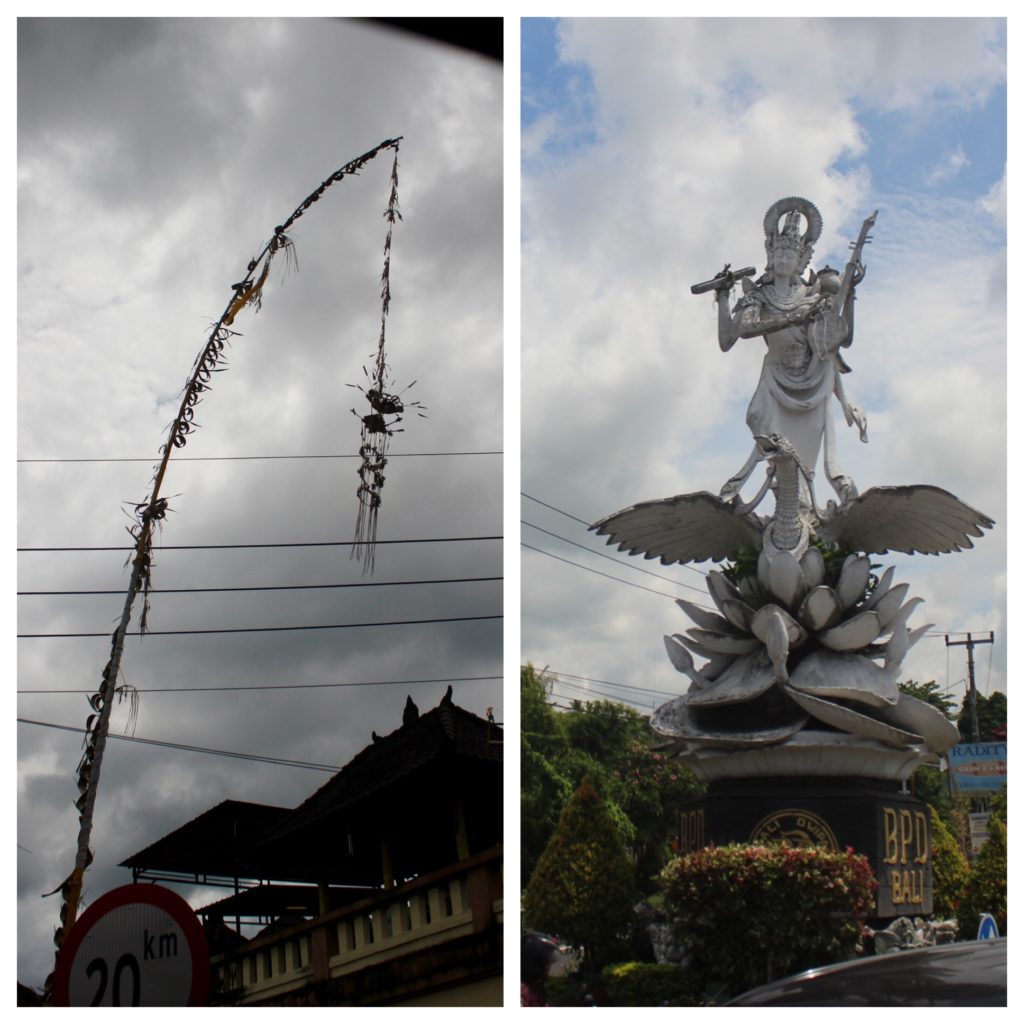
Also along the way there are huge statues displaying scenes from the tales of the Hindu religion. They tower over the buildings around them. They are very beautifully carved and painted.
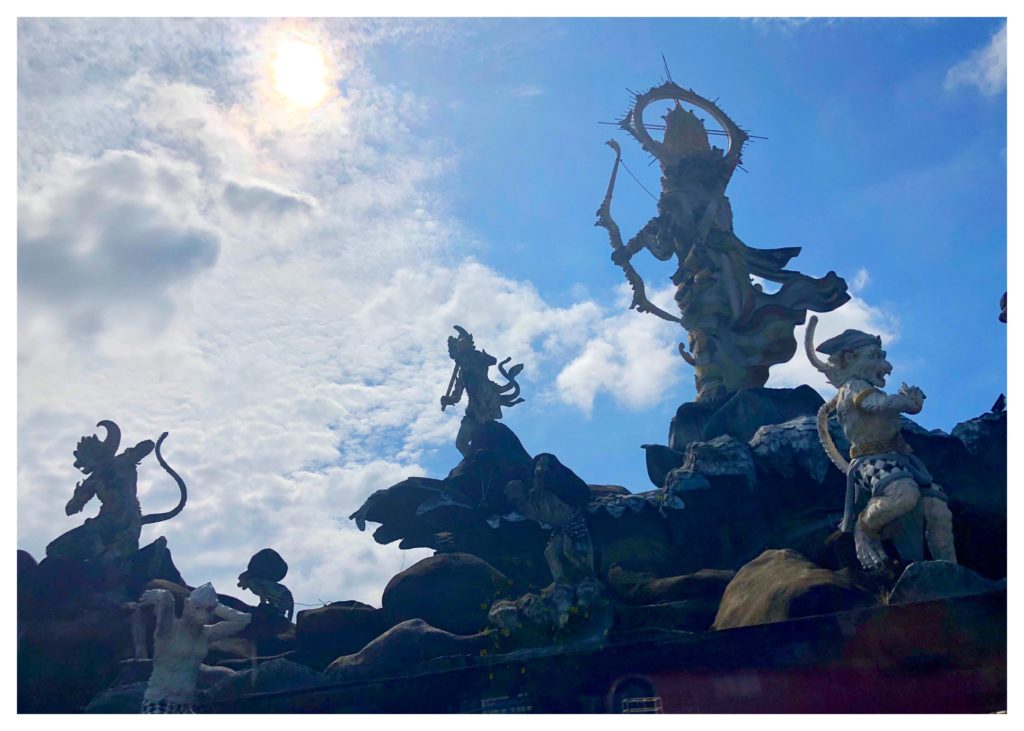
After about an hour and a half, we reached our first stop at the Klungkung Palace built at the end of the 17th century. This was a large royal complex but largely destroy by the Dutch in 1908.
Basically there are only three structures remain: Kerta Gosa (the Hall of Justice) and the Bale (Balinese spelling of Bali, pronounced the same) Kembang floating pavilion and one of the entrance gates.
The Hall of Justice was the court of the high king of Bali. Cases on the island that could not be resolved were transferred to this site. The King, three Brahmana priests, and other officials presided over the court and sat at the table in the middle of the hall. The accused sat on the floor and pondered his fate while viewing the ceiling which depicted different punishments in the afterlife, the results of karma, while they were awaiting sentencing.
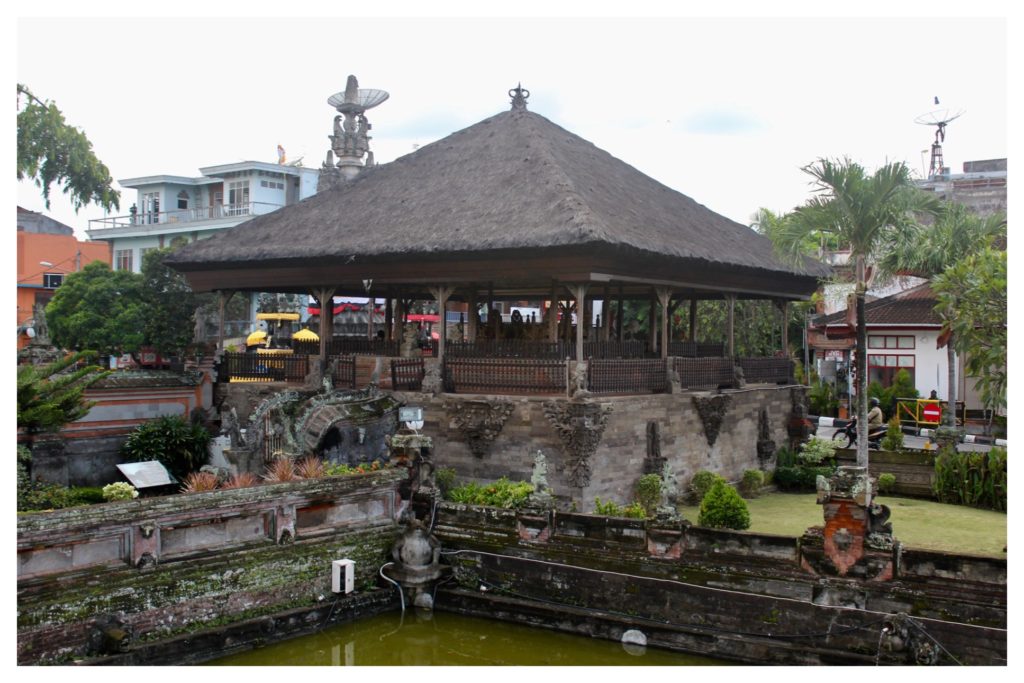
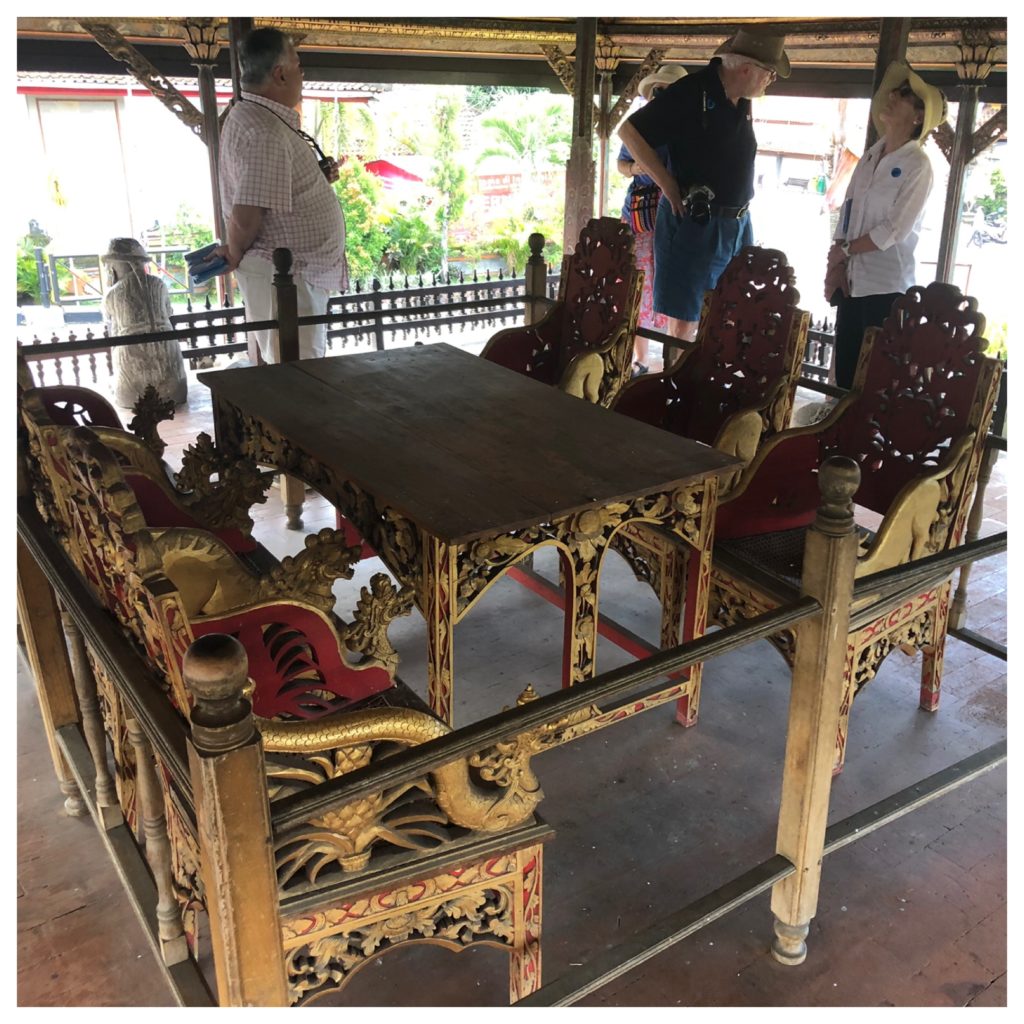
Two scenes pictured here illustrate afterlife punishments: mistreating your parents (parents saw their children in half), and, mistreatment of animals (the animals torture the accused in the afterlife).
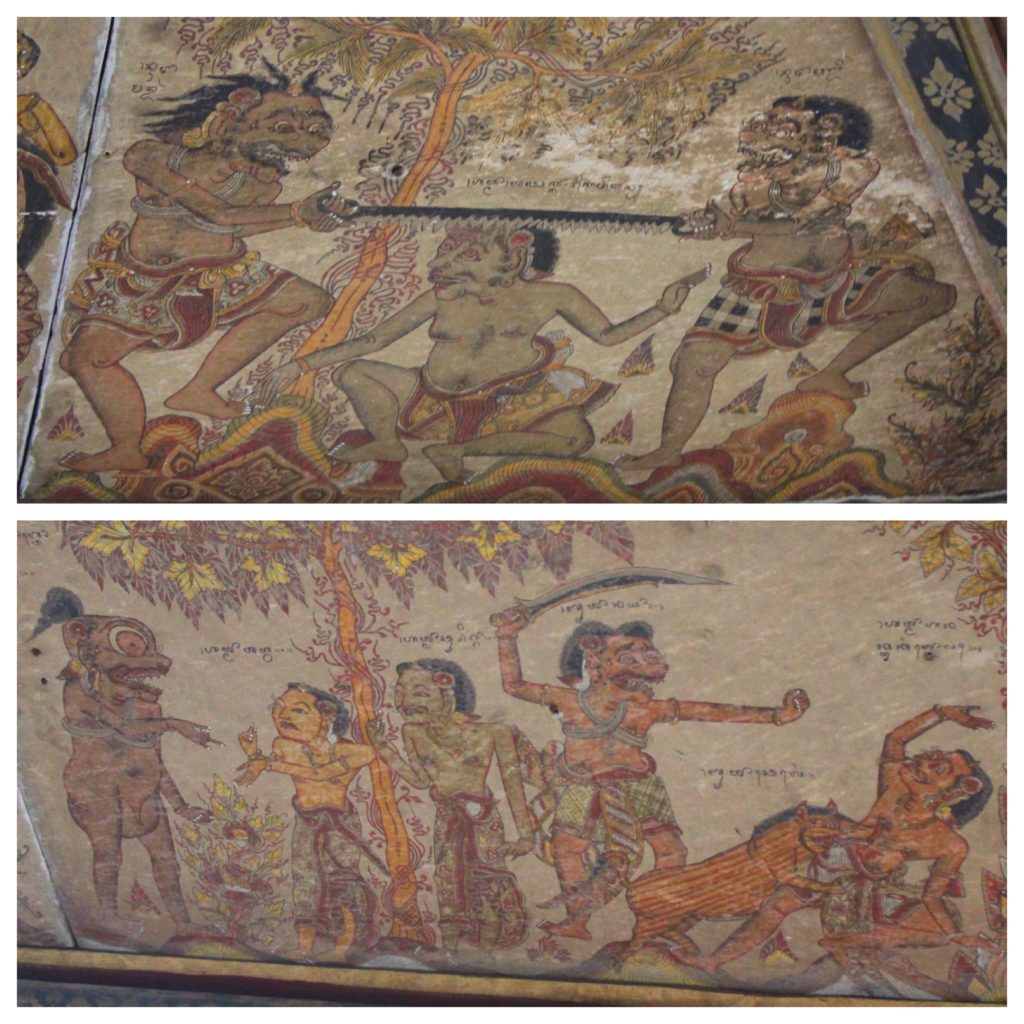
The Bale Kembang floating pavilion was a reception/entertainment hall for the King. The moat surrounding the pavilion gives it the appearance of floating.

At the pavilion and later at the museum we also saw two artisans at work: the first was a man in the floating pavilion completing a painting of a Hindu Religious screen on a handbag, and, a woman weaving a typical Balinese patterned cloth.
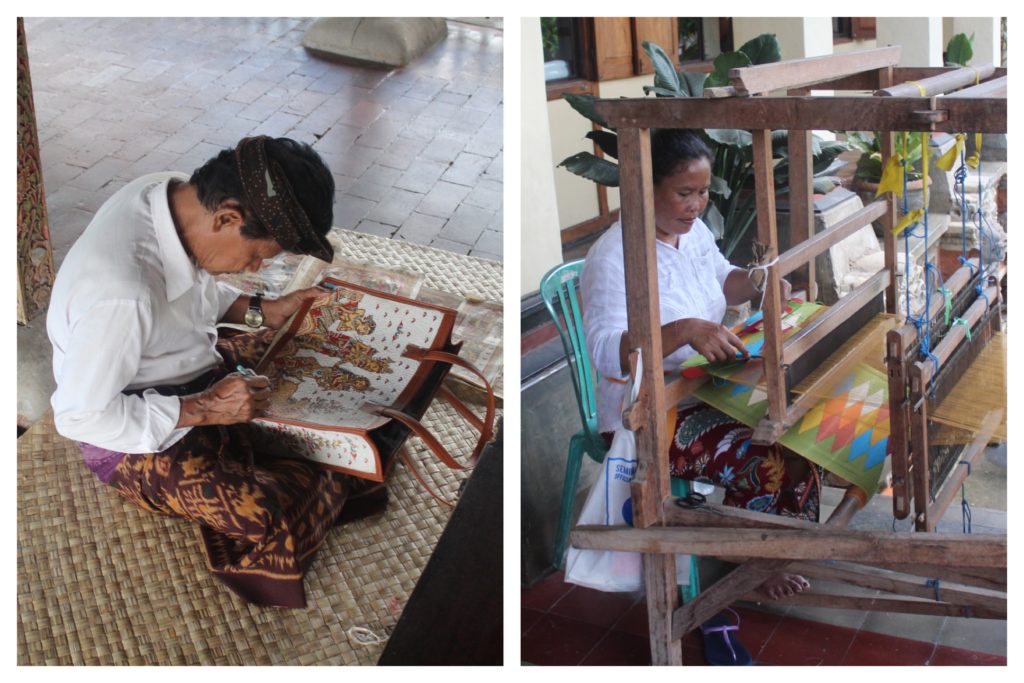
Our next stop was at the Pura Kehen Temple. Because of the religious nature of the site, we were required to wear a sarong if you weren’t wearing long pants. If your legs were covered, you still needed to wear a sash as a sign of respect/reverence.
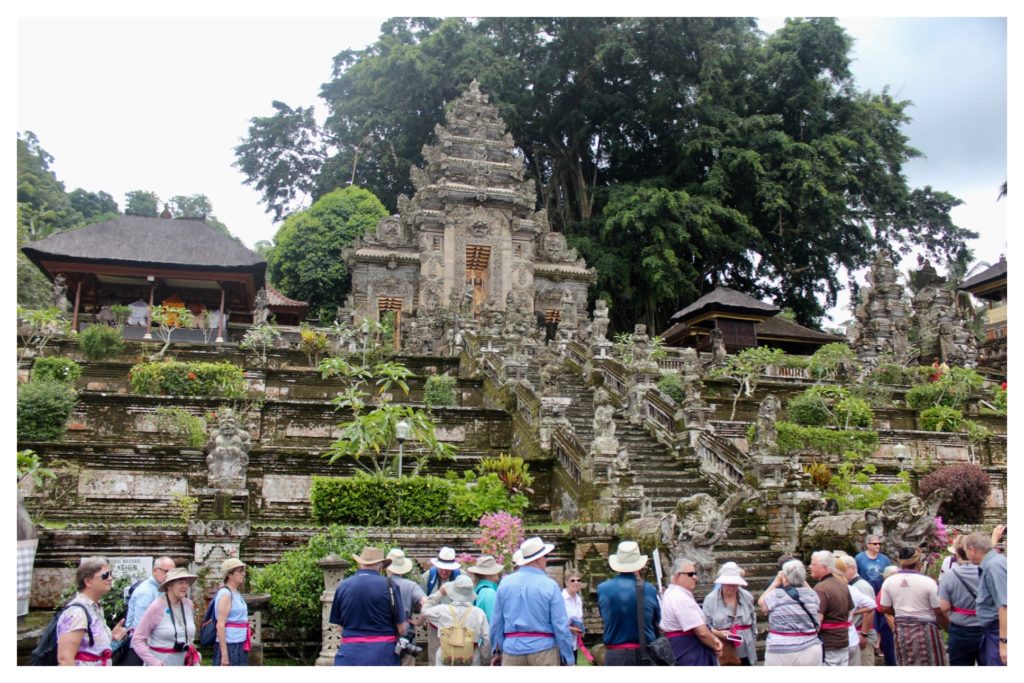
The temple is built into a hillside so you have a few steps two climb before you actually enter the temple complex. At the 1st level there is a huge banyon tree with a shrine built into it’s side a good distance from the bottom. This level also has a few other shrines as well as ceremonial platforms.
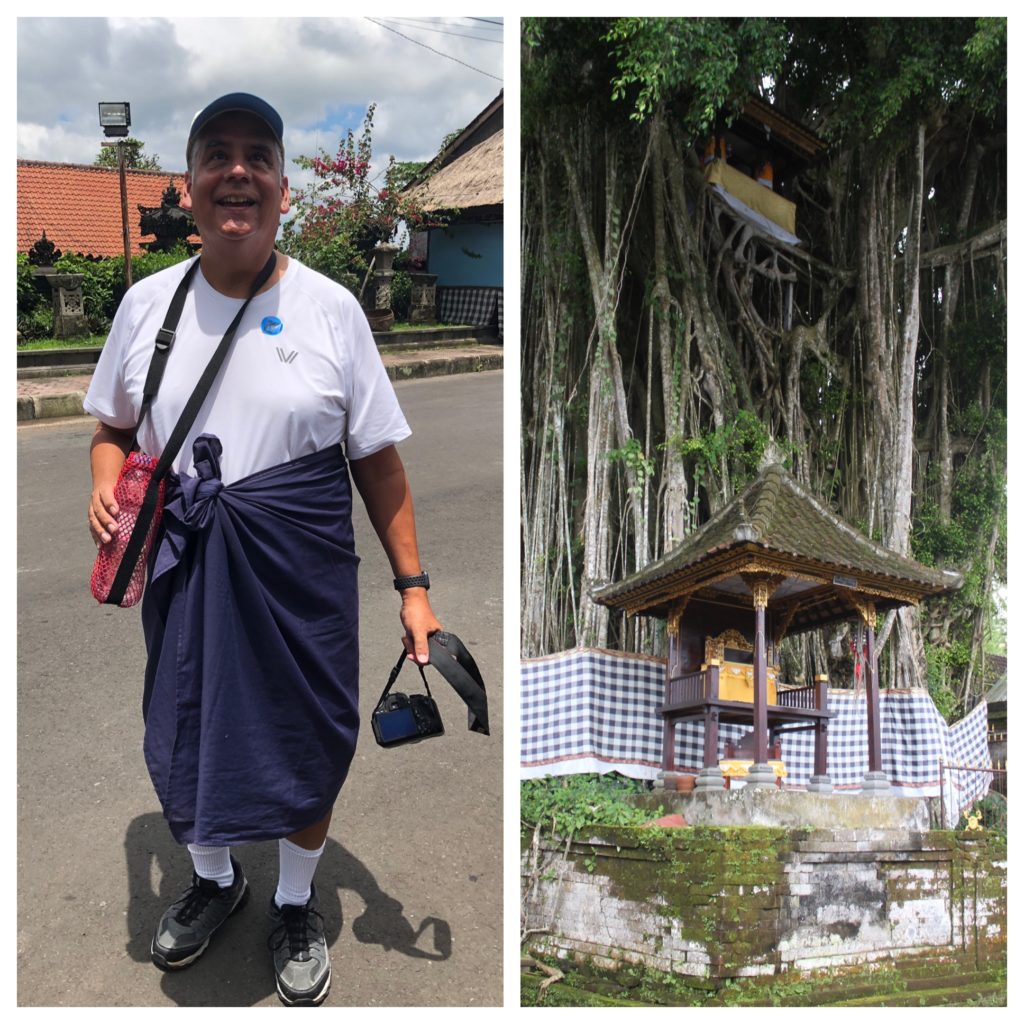
After climbing a few more steps you arrive at the next level which contains several more shrines and platforms. The main structure dominating the level is the pagoda looking structure call a “Meru”. There are 11 levels with each one representing a Hindu alphabet character associate with a Hindu teaching of how to live one’s life.
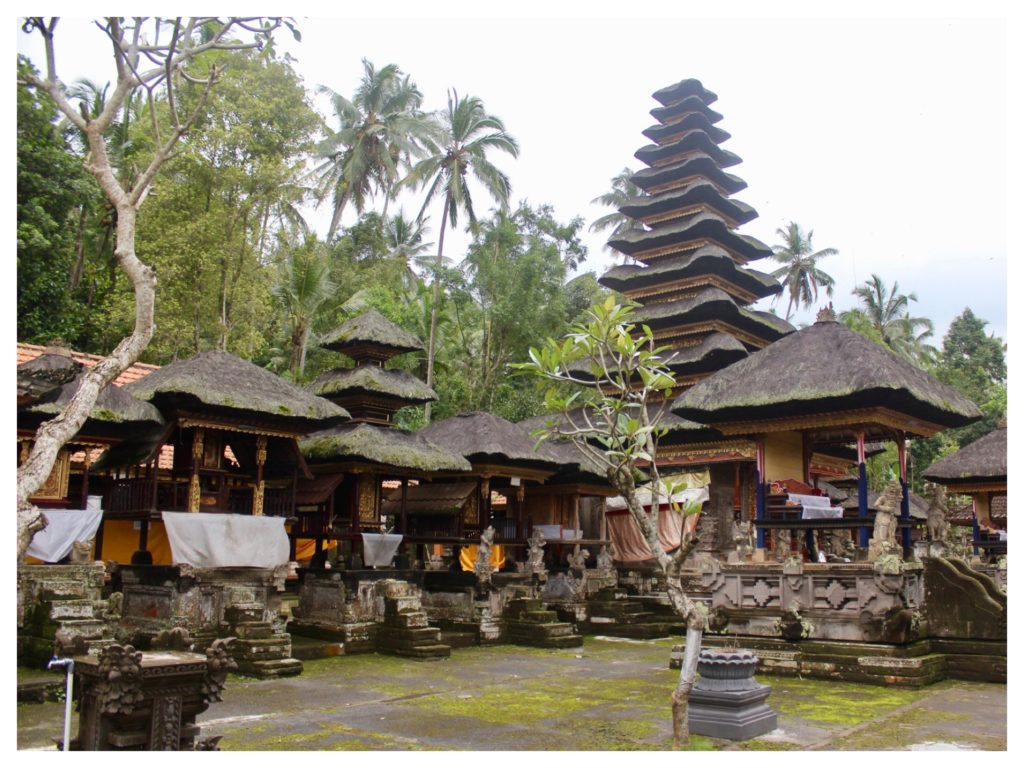
A little higher up they store the ceremonial animals used during their religious ceremonies/festivals.

By now it was time for lunch. Lunch was served at several small open air buildings in the middle of a rice field. To get there we had to walk about 10 minutes from where the buses could park. It was at this time that they heavens decided to open the flood gates and rain! Boy did it rain, buckets and buckets. We all arrived somewhat soaked.
The menu consisted of several typical Balinese dishes: vegetarian spring roll, chips, white rice, smoked chicken, spicy fish satay (on the skewer), a stir fry noodle dish, corn cakes, and twice cooked chicken. We washed it down with a popular local beer. The food tasted great.
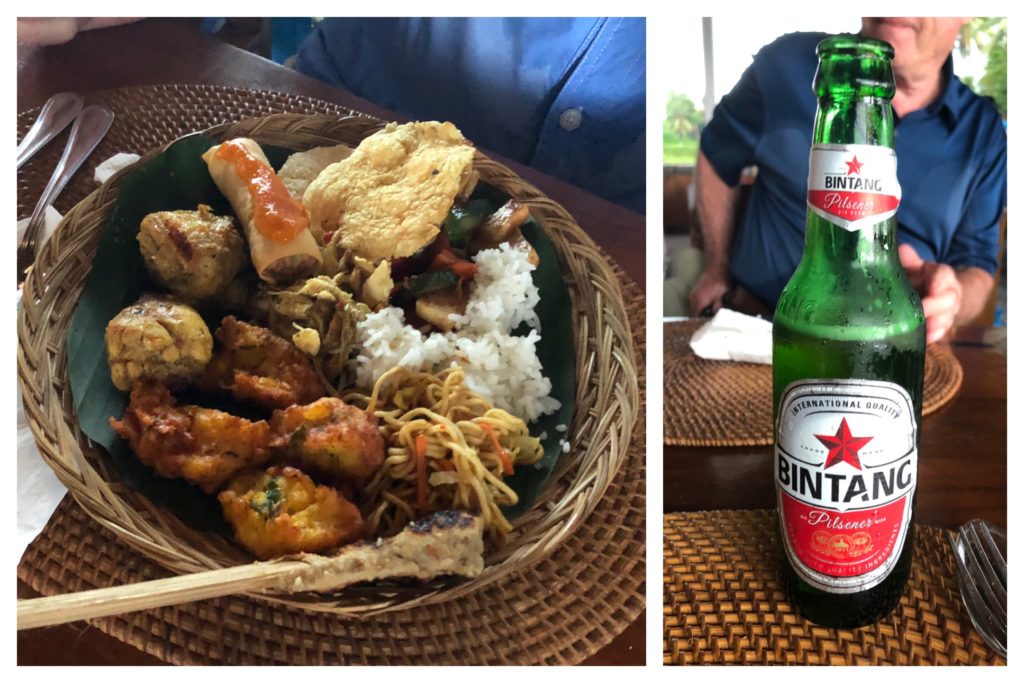
The rain had stopped by the time we finished lunch and some residents began to work in the rice paddy illustrating for us how they planted the rice and how they used oxen to prepared the paddy for planting.
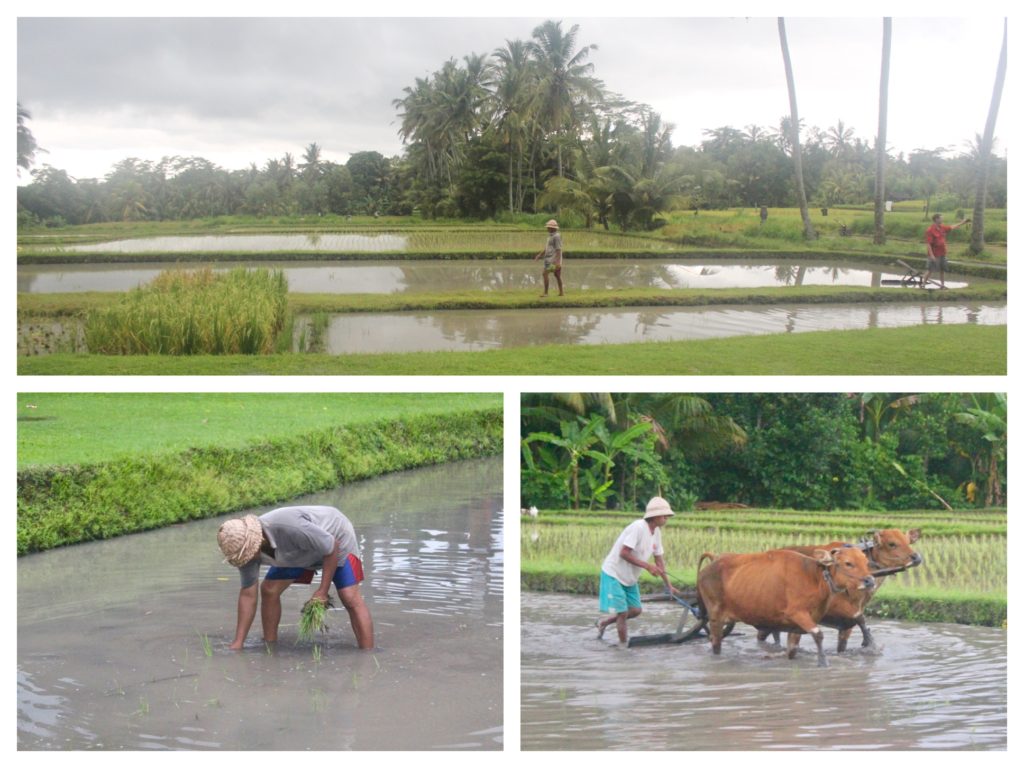
We soon left and were on our way to our last stop at the Royal Palace in Blahbatuh.
This Royal Palace has only been opened to the public for the last 3 years. It is a rather extensive site and is still under restoration. As with Klungkung it has the standard ceremonial pavilions but a much more extensive family temple. Members of the royal family still live on a portion of the site today. They have no governmental responsibilities or influence.
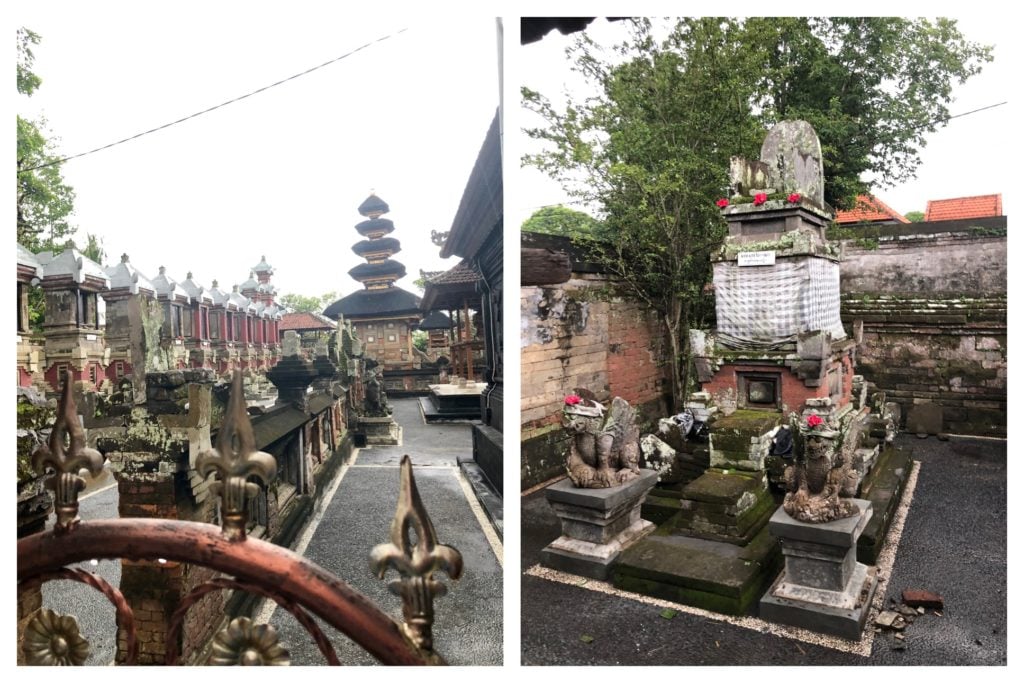
One of the large statues on the site showed the Hindu God Vishnu riding the back of the deity, Garuda. The detail of the carving was truly amazing.

Our final courtyard visited had the floating pavilion. It was said to be used by the King for meditation.
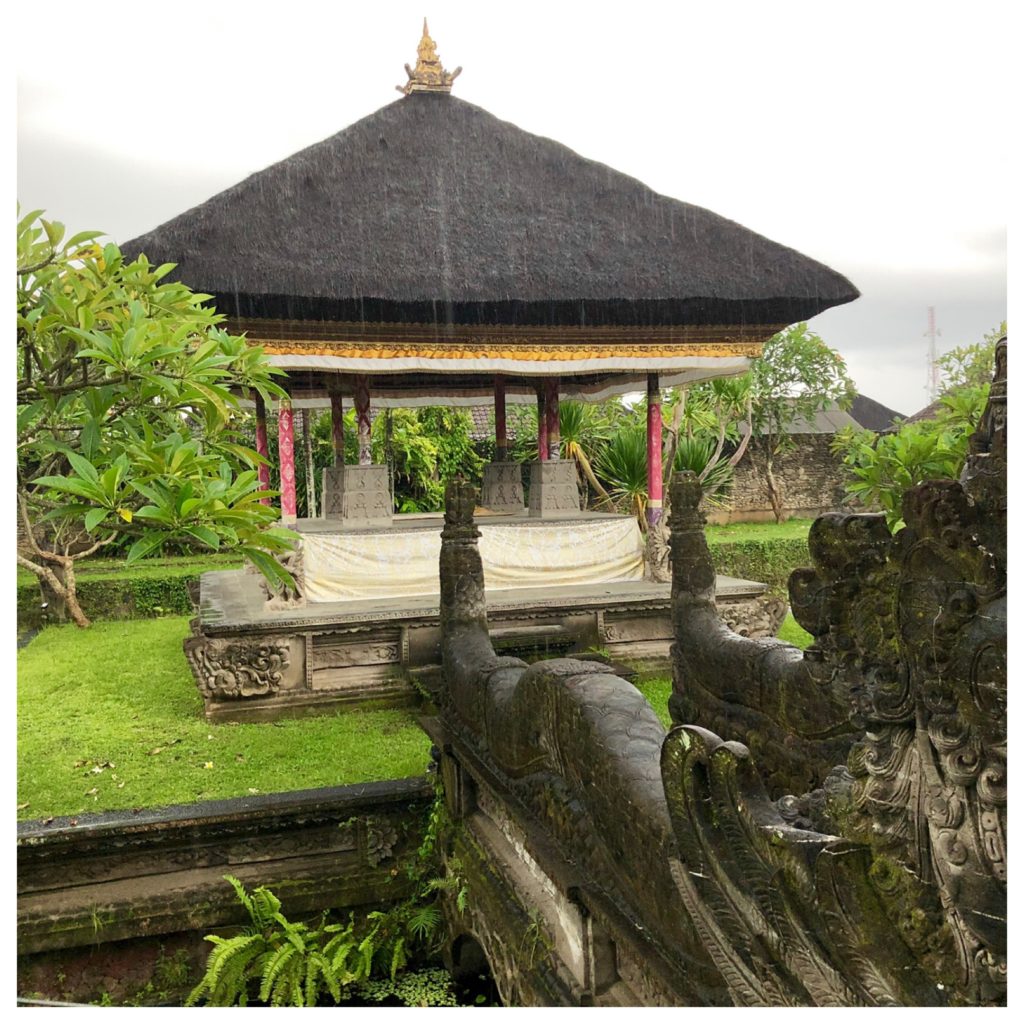
We made our way back to a pavilion at the entrance, drank some tea/coffee, a few Balinese desserts and then it was back to bus and a one and half hour trip back the ship.
Here There Be Dragons!
We arrived in Slawi Bay and tendered onto the island around 9:00am. Our visit today was different from other ports in that unless you were part of an excursion group, you couldn’t leave the ship. This is one method countries are using to better control crowds and protect their natural environments.
For the next few days we’re getting closer to the equator so the weather is getting hotter and the humidity is almost 100% every day. Today the temperature was about 88 with 98% humidity. We needed to carry big bottles of water everywhere we went.

Today’s tour was a two hour walk thru the monsoon forest to see the famous Komodo Dragons!
We met our tour guide and two additional park guides on the island. The two additional park guides were there for our protection with one of them walking at the front and the other the rear of the group. Each one carried a forked stick they would use to guide a dragon away from the group should they get too near.

Sometime around September, Female dragons lay 20-30 eggs once a year in a huge nest and then leave. The eggs take about 9 months to mature and hatch around April. The baby dragons will immediately climb into the surrounding trees (if they haven’t been eaten by other larger dragons). They may also burrow into dead palm trees since the interior is very soft. They live in the trees for two years before they come down to live on the ground.

Some scientists believe that when a dragon attacks an animal it will secrete a poisonous saliva. This saliva contains over 60 different types of bacteria. The animal may take from 1 to 7 days to die from the bite. The dragons will be able to detect the dead animal using their extremely sensitive smell.
However, most scientists believe they eat their prey alive by biting them and ripping at them with their claws. In some cases they’ve been known to swallow their prey whole!

Our walk took us to two waterholes in the forest. At the first one we saw a group of 4 dragons. Our guide made sure we stayed well away from them. They occasionally got up and walked around but fortunately they left us alone (they also didn’t look hungry). These were four males about 6 ft and weighing approximately 150 lbs each.

We continued on to the 2nd waterhole where we saw 3 more dragons: 2 males and 1 female. They appeared to be asleep but I’m sure they kept an eye on us.
Along the way we also saw deer and wild boars as well.
After our tour, as we walked to the souvenir stands, a dragon suddenly appeared and headed towards the stands. About 20 feet before the stands, he turned off the path and into a wetland area. Everyone was relieved!

During the cruise, some people do charitable work along the way. A very good example is Project Linus (“Security through Blankets”) where passengers knit and crochet blankets for seriously ill or traumatized children. There are Project Linus chapters in many places (even Burbank and San Fernando Valley), but these blankets go to the Seattle chapter of Project Linus because the Holland America corporate offices are in Seattle.


The patterns and colors of these blankets are as varied as the passengers on the ship. There is a certain time and place on the ship (affectionately called Hooker’s Corner) each Sea Day where passengers meet and work and can pick up the donated yarn, hooks or needles, but we often see people working on their blankets in many places and at all times around the ship. Because some passengers are leaving the ship in Singapore, the end of a “segment”, an exhibition of the 125 blankets finished so far was held today. The goal is to have 200 finished blankets by the end of the cruise.


It is good to know that the time between ports is used so generously by these passengers. The yarn is donated by Holland America, but I think some passengers bring yarn from home for these projects as well.
Just a quick note before we talk about Darwin. In our Cairns post we mentioned the danger of swimming in the ocean beaches because of saltwater crocodiles. However this also applies to freshwater crocodiles in rivers. We made this sound like its only a problem in Cairns. That’s not true. We started seeing warning signs in Townsville. The crocodile problem seems to be prevalent all along the northern coast even in Darwin. Seems sad that Australia has all those beaches and can’t use them without taking safety precautions.
On to Darwin!
Darwin is the capital city of the Northern Territory of Australia with a population of about 150,000. It is named after naturalist Charles Darwin. The two largest sources of income are mining and tourism. The city has been destroyed and rebuilt 4 times due to cyclones and Japanese air raids. The latest was Cyclone Tracy in 1974.
Our tour today was to the Territory Wildlife Park about an hour outside of Darwin. This park specializes in animals indigenous to the Northern Territory.
During WWII Darwin was a major staging area for allied attacks on Japanese forces. The Japanese bombed Darwin multiple times during the war with the biggest attack using the same fleet and air forces that attacked Pearl Harbor. While traveling on the Stuart Highway on our way to the park, we saw remnants of the landing strips along the side of the highway used by American and Australian fighters to attack the Japanese.

Also along the way we saw some termite mounds. It’s hard to tell from the picture but this mound is about 5 ft tall. They say that the nest continues for the same depth underground!
We also saw the unusual corkscrew trunk of the Pandanus palm. Paul and I ate some pancakes made from the Pandanus fruit when we were in the Majuro Islands in 2017.

When we arrived at the park we saw these cute kangaroos made out of machine parts outside the entrance. Our tram driver, Andy, met us there also. Could this guy look anymore Australian? Notice the sweat. It was already over 90 and very humid by the time we arrived. It only got worse.

The park is divided into 5 sections. We hopped on the tram and drove off to the first section which was the Nocturnal House. The tram stop of each section is decorated with a piece of artwork in the Aboriginal style. The snake was great!

The Nocturnal House contains animals that only venture out at night. We saw many animals two of which were the Northern Quoll, a small carnivorous marsupial, and a Nabarlek, a small rock wallaby (marsupial) found nowhere else in the world! It has the unique ability to continually regenerate it’s molar teeth. This is probably due to their abrasive diet.
At the end of the house was a table displaying what a bowl of food would be like for each of the animals.

We then re-boarded the tram and went to see the bird show at the Flight Deck section. The show was very good and we got to to see examples of beautiful birds ranging from the small Beach Stone Curlews, a gorgeous barn owl, and the huge emu. We also saw an osprey, black feathered eagle, and kites all of which were predators.


At this point we were very hot and we rode the tram back to the entrance to eat some lunch and cool down. We each had a popular brand of Aussie meat pie called “Tommo’s”. Paul’s pie was beef, bacon, and cheddar while mine was steak and mushroom. Both were very delicious.

We had time for a visit to one more section so we hopped on the tram and went off to visit the Billabong which is a wetlands area. It was a beautiful lagoon. The main attraction in the Billabong were the Australian Pelicans. In order to stay cool they were constantly fluttering their gular pouch. Unfortunately we only had a few glimpses of other animals. I suspect they had more sense to stay somewhere cool.

Sadly our time ran out and we had to return to the ship.
At dinner they served an Australian themed menu. The main course? Australian meat pies!
Cairns is a city on the northeastern coast of Australia and is often called the “Gateway To The Great Barrier Reef”. It is also a major port for exporting sugar cane, gold and other metals, minerals and agricultural products from the local area.
We’ve been cruising between the Reef and mainland Australia for the last two days. We’ve crossed it twice but only at night so we’ve not really seen it. During the day we stay quite a distance away. Buoys mark locations where the Reef begins.

If you want to visit the Reef you take a shuttle from Cairns and then transfer to a smaller boat, which is usually glass bottomed, at a platform just off the Reef. Or for more dollars more, you can take a helicopter out to the platform. If you’re feeling really adventurous you can pay to snorkel or scuba dive.

Another important feature of Queensland is their rainforests. Our tour today was “Rainforest and Aboriginal Adventure”. We drove to the Rainforestation Wildlife Park located in the Kuranda Rainforest about an hour outside of Cairns in the mountains.
The park is divided into 6 different sections.
Section 1 was a demonstration of how to play the iconic Aboriginal instrument, the “digeridoo”. It’s basically a tree branch that’s been hollowed by termites and finished off with fire. It’s not easy to play but it sounds great with its low thrumming sound.
Section 2 was learning how to throw a spear. Spears were used by the Aboriginal in hunting various animals including kangaroos. Again it’s not as easy as it may appear. Spears can be thrown by themselves or thrown using a “woomera”. The woomera is a wooden device that will increase the distance and power of the thrown spear. Two previous presenters here at the park held the Guinness record for spear distance.
Section 3 was all about throwing boomerangs. As with all weapons there’s really one right way to hold and throw it. Did you know there’s a left handed and a right handed one? It’s a good thing that the passengers don’t have to hunt to eat on the ship as our throwing was terrible. Paul came in with the 2nd best throw of our group!

Section 4 was an animal walk. They had a small zoo with native animals many of which just roamed around in the enclosure.
One animal of note was the large bird called a “Cassowary”. It’s basically a fruit eating flightless bird. It has huge feet and 3 claws for digging however I don’t think you’d want to get into a fight with it. Very colorful.
Some of the animals roaming around were kangaroos and wallabies. Ron was able to feed and pet one. He said the fur was very soft. Kangaroos and wallabies do occasionally mate and they produce a “wallaroo”.
One of the important displays here were the saltwater crocodiles. In Cairns, you can only swim in designated, netted areas. If you swim anywhere else, you risk getting bitten by these guys. These are small versions of what’s out in the Australian waters.
I guess it was break time here at the zoo as many of the kangaroos laid down for a rest. They looked quite happy not to be bothered by the people milling around.
Of course there were Koalas, wombats, etc., in the park as well but we’d seen them on other tours.

Next we moved on to Section 5 which was a demonstration of Aboriginal dances. There were dances about mosquitoes, emulating emus, honey tree harvesting, and tribal warnings. They even brought a few passengers on stage and taught them one of the dances. It was not a pretty site.
Our final Section 6 was our “Duck” tour on a WWII amphibious vehicle. They drove us around the forest and nearby lake showing us both useful and dangerous plants. Due to the heavy rain at times we only saw one lizard and no other animals. It rained heavily several times during our visit, but since this was a rainforest it simply added to the experience rather than feeling like a problem.
As we left the park, we heard loud screeching noises coming from the nearby trees. The sounds were made by wild parrots but they were very beautiful.

When we arrived back at Cairns, our guide pointed out several trees full of what appeared to be hanging fruit. That was not the case. These were fruit bats! There must have been hundreds of them in the trees waiting for night to go hunting for food. Glad we left port before the sun went down.
Sadly we’ve only got one more port in Australia, Darwin. We’ll be there in three sea days.